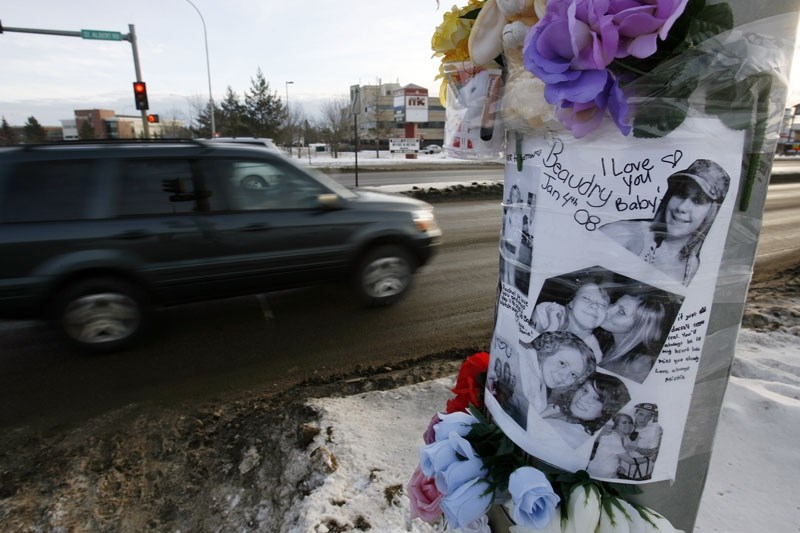Intersection safety in St. Albert – particularly at intersections along St. Albert Trail – has fallen into sharp relief in the last month since a vehicle collision claimed one life in a late night crash.
Most pointedly, Mayor Nolan Crouse has been asking questions at city council meetings about what, if anything, the city is doing to make those intersections safer. The statistics he has shown demonstrate that three intersections along St. Albert Trail – where it intersects with Boudreau/Giroux, Bellerose/McKenney and Hebert/Gervais – have the most injury collisions of all the intersections in St. Albert.
But at what point does a number become a problem? And what more, if anything, can the city do to prevent those collisions?
“I think you need to be concerned,” said Crouse. “One accident is too many. One fatality is too many. I know you can’t regulate stupid but I think you have to put everything in place to minimize the impact.”
The numbers the mayor has been showing council certainly prove St. Albert Trail is where the crashes happen. In a five-year span, from 2006 to 2011, there were 61 injury collisions at the trail and Boudreau/Giroux, 58 at the trail and Hebert/Gervais and 47 at the trail and Bellerose/McKenney.
But look at those numbers in more depth, says Brian Hartman, the city’s manager of engineering. Averaged out over the five-year interval, that represents 12.2 crashes per year at Boudreau/Giroux, 11.6 per year at Hebert/Gervais and 9.4 at Bellerose/McKenney.
“That’s not even a collision a month (at those three intersections),” says Hartman.
And Crouse’s numbers aren’t even the most current. Statistics for each of those three intersections between 2010 and 2012 show that the number of injury collisions at those three intersections fluctuate wildly. At Boudreau/Giroux, there were 19 in 2010, six in 2011 and 14 in 2012. At Hebert/Gervais, that number was 10 in 2010, 11 in 2011 and 19 in 2012. McKenney/Bellerose was more consistent at five each in 2010 and 2011 and three in 2012.
But the greatest factor in determining how many collisions occur at each intersection is volume, Hartman says. Simply put, the more cars that pass through an intersection, the more likely it is accidents will happen at those intersections.
“The majority of collisions occur at intersections,” Hartman said. “That’s a statistic across the Capital region. As traffic volumes increase, the likelihood of there being a collision increases as well.”
The city’s traffic counts from the last year help paint part of that picture. St. Albert Trail is by far the busiest road in the city – almost 420,000 vehicles per day use the road. The busiest part of the trail is at its south end, just before Hebert/Gervais, with almost 107,000 vehicles passing through.
When it comes to the individual intersections, it is easy to see why most injury collisions occur at Boudreau/Giroux, Hebert/Gervais and Bellerose/McKenney. Roughly 45,000 vehicles enter the intersection at the trail and Boudreau/Giroux, compared to 80,000 at the trail and Hebert/Gervais and 58,000 at the trail and Bellerose/McKenney.
With these kinds of numbers, Hartman and his crew can better judge just how dangerous an intersection can be, simply by doing the math and seeing how many accidents occur per 1,000 vehicles that pass through. Boudreau/Giroux and the trail comes in at 0.31 injury accidents per 1,000 vehicles. Hebert/Gervais is 0.24 and Bellerose/McKenney is 0.05 per 1,000 vehicles.
“In terms of how many vehicles go through and occurrences of collisions, the frequency isn’t that high,” said Hartman.
And it’s not just the traffic on St. Albert Trail alone that is a factor. Hartman points out that all three intersections have traffic coming in from other directions.
“We can’t always assume it’s the north-south traffic on the trail,” Hartman said.
Other developments east and west of those intersections can contribute to traffic congestion and volume as well, Crouse noted. At the trail and Boudreau/Giroux, there’s the Sturgeon Community Hospital and a shopping centre to contend with. At the other two intersections, there are large shopping centres on every side of the road.
“If you have traffic start backing up that way, you will cause new accidents and new intersection problems,” Crouse said.
But even with the low frequency of injury collisions, the city is still going to be reviewing some of its intersections to ensure it is doing all it can. This summer, it will look at 36 of its intersections across the city, looking at different elements such as design, visibility and any other improvements they can make to improve traffic flow and make each intersection as safe as possible.
“We’ll look at traffic counts, road user demands, and the biggest part is the safety component,” said Hartman. “It’s always a priority.”
Mayor Nolan Crouse has already scribbled down some thoughts on elements to examine. He noted that all three intersections have red-light cameras and speed-on-green cameras. But this technology, which he feels make the intersections safer, hasn’t yet been installed to cover all four directions of travel.
The delays in installing cameras at all points of all three intersections has been attributed to ongoing roadwork. Crouse said he intends to start advocating that this expansion be undertaken as soon as possible.
There are other distractions, Crouse noted. The new digital signs erected by the St. Albert & District Chamber of Commerce at both ends of the city might serve as a distraction, as might some of the other signage that is prominent at all three intersections, he said.
“Why do I know this? Because I’ve been distracted by looking at them,” Crouse said. “Why do we have these big signs right at intersections?”
The number of injury collisions might not appear large on a spreadsheet, Crouse said, but that doesn’t mean St. Albert can't do more to ensure they never happen.
“Pilots aren’t allowed to have crashes and doctors aren’t allowed to drop babies,” he said. “Those accidents are what you have to essentially eliminate.”




